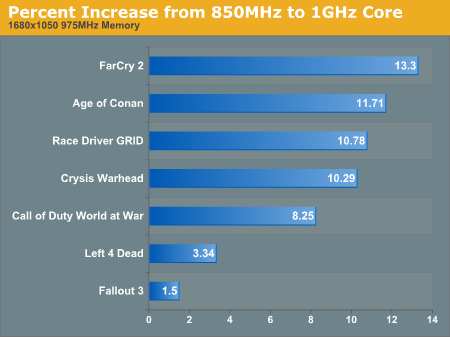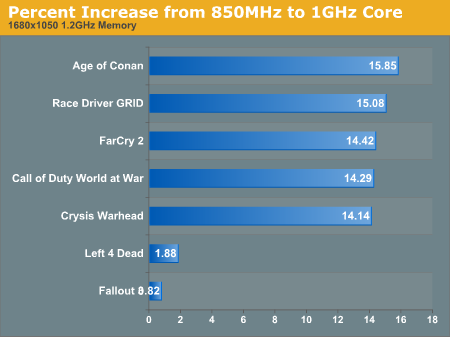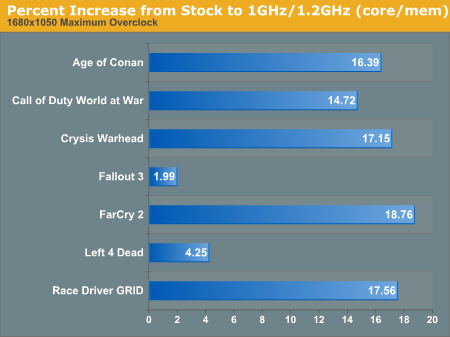Overclocking Extravaganza: Radeon HD 4890 To The Max
by Derek Wilson on April 29, 2009 12:01 AM EST- Posted in
- GPUs
Combined Memory and Core Overclocking: The Sweet Spot
In this round of tests, we combine our previous maximum overclocks. This is our compromise, in that we show the maximum potential of combined core and memory overclocking rather than effects of memory overclocking over each core clock speed we tested. While the latter option would be more complete, our tests do enough to show people what they need to know to find the sweet spot.
We theorized that with an extreme core clock speed that memory may have become a bottleneck to performance at some point. Despite the fact that increasing memory clock without increasing core clock didn't do much at all, we could see increased benefit beyond what one might expect based on our initial memory overclocking results.
Before we looked at varied memory clock with a stock core clock and varied core clock with a stock memory clock. Let's revisit both of those but also add in a twist. We will also look at percent increase in performance when overclocking memory with a 1GHz core clock and the percent increase in performance when overclocking the core with a 1.2GHz memory clock.

1680x1050 1920x1200 2560x1600

1680x1050 1920x1200 2560x1600

1680x1050 1920x1200 2560x1600

1680x1050 1920x1200 2560x1600
Note that in both cases we see a much bigger boost in performance. This means that while applications tend to be very heavily compute limited, at higher core clock speeds on AMD hardware memory bandwidth increasinly becomes a bottleneck. Now let's take a look at what we get when going from a completely stock part to a maximally overclocked part at 1GHz/1.2GHz (core/mem).

1680x1050 1920x1200 2560x1600
To get a basic idea of what's going on, here's an example of two programs. Remember that this isn't really real world and is just to illustrate the concept.
The first application is completely compute bound and the second is 50% compute bound and 50% memory bandwidth bound. Both tests generate 100 frames per second on a stock Radeon HD 4890. If we increase core clock speed 10%, the first application will generate 110 frames per second, while the second one would only generate 105. This is because we only see the 10% benefit while doing half of the work. If we look at only boosting memory performance 10%, the first program delivers only 100 fps while the second hits 105 again. Pushing both memory and core clock speed up 10% each gives us 110 frames per second from both applications. Basically.
Nothing is really that contrived or works like that, but the important thing to remember is that different applications can make varying use of different resources, and balancing those resources is important to ensuring the best performance in the most efficient package.
So, to find the sweet spot for your overclock, you will want to increase core clock speed as much as you can. Then bump up memory clock and see how high you can get it and remain stable. Use a real world application to test performance at each point and then use a binary search like algorithm to find the sweet spot in a short number of tests. And there you have it. We didn't do this for you, but what's better practice than a little hands on experience right? Besides, if gives readers the opportunity to compare notes in the comments on what the optimal memory clock for a 1GHz core clock on the 4890 would be. Have fun!










61 Comments
View All Comments
Sylvanas - Wednesday, April 29, 2009 - link
This is exactly the kind of review I like to see, overclockability is a major factor for me in purchasing new hardware. Better than the 4890 launch article, good job.SiliconDoc - Saturday, June 6, 2009 - link
Better remember this then:" We absolutely must caution our readers once again that these are not off-the-shelf retail parts. These are parts sent directly to us from manufacturers and could very likely have a higher overclocking potential than retail parts "
Live - Wednesday, April 29, 2009 - link
I really liked this article. Covered everything needed and was very informative.GeorgeH - Wednesday, April 29, 2009 - link
Interesting read, but I was a bit disappointed not to see the 4850x2 included in the benchmarks. The 1GB model is currently at very rough price parity with the 4890 and the 2GB model still cheaper than a 285. As such, it would've been nice to be able to more easily note the advantages of a multiple GPU card over a single GPU card cranked up to ludicrous speed.Minion4Hire - Wednesday, April 29, 2009 - link
The numbers used for the 4850 in this article correlate to those in the Multi-GPU article from February. So all you really need to do is compare the 4850 X2 results from that article to the 4890 results in this article. The two are closely matched, although I'd be willing to bet that the perceived performance and fps range is tighter and more consistent on the 4890 than the 4850 X2, as single GPU solutions usually are.Tuvok86 - Wednesday, April 29, 2009 - link
You'd better undervolt rather than underclocking.My 4890 manages a good downvolt at stock speed, resulting in low temps
kmmatney - Wednesday, April 29, 2009 - link
That is a good point. I have setup a 2D profile in ATT which undervolts the card (you can undervolt, but not overvolt with ATT) and that does help in 2D. I haven't tried undervolting at stock speed (although mine's a OC version, so it may need the full voltage).kmmatney - Wednesday, April 29, 2009 - link
I have an HD4890 and it does overclock well. But it's just too damn loud. I've been actually underclocking it for most of my games, as its fast enough to run them fine while underclocked, and it keeps the noise down. It's just not fun running it overclocked and having your game drowned out by a hairdryer. Headphones help.Veteran - Wednesday, April 29, 2009 - link
The title is a little bit stupid if you ask me, a 4890 can go way further then 1GHz on the core and 1.2GHz for the RAM. Why didn't AT go further then normal achievable clocks? The title says to the max, too bad it cannot make up the promise.Interesting read though, must have cost a tremendous amount of work.
DerekWilson - Wednesday, April 29, 2009 - link
Well ... it is to the maximum value the built-in overclocking features of the driver will let you set the card. So that's where "to the max" came from.Yes with 3rd party tools you can get higher on some hardware, but we didn't want to go into aftermarket cooling and not everyone can even make it to 1GHz ... We wanted this based somewhere in achievability.
And I'm glad it was interesting :-)